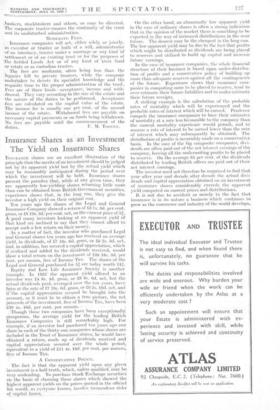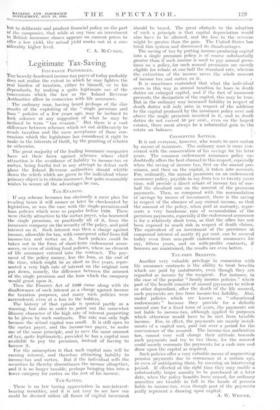Insurance Shares as • an Investment . The Yield on
Insurance Shares
INSURANCE shares are an excellent illustration of the principle that the Merits of an investment should be judged not by its apparent yield but by the actual yield which may be reasonably anticipated during the period ovei• which the investment will be held. Insurance shares present the paradox: that, ,7hile at ,any given time, they are apparently low-yielding shares returning little more than can be obtained from British-Government securities, experience shows that, in . the long run, they give the investor a high yield on their original cost. Ten years ago the shares of the Legal and General Insurance Company showed a return of £3 7s. 3d. per cent. gross, or 21-12s. 2d:per cent. net; on the mix-rent price of 5f. A:good many investors looking at an apparent yield of that kind arc inclined to say that they cannot afford to #ecept such a low return on their money. . :As a matter of fact, the investor who purchased Legal and General shares ten years ago has received an average jrield, in dividends, of £7 18s. Od. gross, -or /6 2s. 3d. net, arid, in addition, has secured a capital appreciation, which realized and and added to 'the 'dividends received, would pow a total return on the investment of 138 18s. 8d. per I,0t. per annum, free of Income Tax. The shares of the Legal and General purchased for 5f are today worth 24. 'Equity and Law Life 'Assurance Society is another eXample. In 1-025 the apparent yield offered to an investor was £4 8s. 4d. gross, or /8 8s. 6d. net, but the actual dividends paid,.averaged over the ten years, have t)elen at the rate of £7 18s. 6d. gross, or £6 2s. 10d. net, and if the capital appreciation secured be brought into the account, as it must be to obtain a true picture, the net. preceeds of the investment, free of Income Tax, have beeri £30 4s.-.10d. per cent, per, annum. . Though these two companies have been exceptional' prosperous, the average yield for the leading British Insurance Companies is still remarkably high. For example; if an investor had purchased ten years ago one share in each Of the thirty-one companies whose shares are ineluded in the Trust of Insurance shares, he would have. obtained a return, made up .of dividends receiled and capital appreciation secured over the whole period; equivalent to a yield of 111 4s. 10d; per cent, per annum; free of Income Tax. A CONSERVATIVE POLICY.' 1 The .faet is that the. apparent yield upon any given investment is a half-truth, -which, unless qualified, niay be Very misleading. To purchase Stock Exchange securities: oh the basis of choosing .those. shares which showed the highest apparent 'yields on the prices quoted 'in the official list would, as ,everyone knows, involve tremendous risksi of capitaLlOssesi-, •. • . On' the other hand,- an. abnormally low apparent yield in the case of ordinary shares is often a strong indication that in the opinion of the .market there is something to be expected in the way of increased, distributfonsin the near future. The dearest may be the cheapest in the long run. The lo* apparent yield May be due to the fact that profits which might be distributed as dividends are being placed to reserves and utilized to build up capital and increase future earnings. In the ease of insurance companies, the whole financial structure of their business is based upon under-distribu- tion of profits and a conservative policy of building up more than adequate reserves against all the contingencies of the future. Experience shows that -insurance com- panies in computing sums to be placed to reserve, tend to over-estimate their future liabilities and to under-estimate their future receipts. A striking example is the calculation of the probable rates of mortality which will be experienced and the probable rates of interest which will be -earned. Prudence compels the insurance companies to base their estimates of mortality at a rate less favourable to the company than the current mortality, experience would permit, and to assume a rate of interest to be 'carried rdwer'than the rate of interest which may subsequently be obtained. The distribution of profits is invariably made on a conservative basis. In the case of the big composite companies, divi- dends are often paid out of the net interest earnings of the company, leaving all the underwriting profits to be placed to reserve. On the average 85 per cent, of the dividends distributed by leading British offices are paid out of their net interest earnings.. The investor need not therefore be surprised to find that year after year and decade after decade the actual divi- dends and capital appreciation obtained on an investment of insurance shares considerably exceeds the apparent yield computed on current prices and distributions. It is not. due to accident or merely to the fact that insurance is in its nature a business which continues to grow as 'the commerce and industry of the world develops; but to deliberate and prudent financial policy on the part al the companies, that while at any time an investment hi British insurance shares appears on current prices to iDffer a low yield, the actual yield works out at a con- laderably higher level. C. A. MeCuany,



























































 Previous page
Previous page